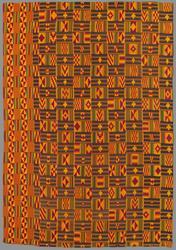Advanced Search 
Kente cloth
Bed cover made from half of man's wrapper (kente)
Mid-20th-century examples of strip-woven prestige cloths called kente, were made by the Asante (or Ashanti) people of Ghana, mostly in the town of Bonwire. Composed of twenty-four handwoven strips (each about four inches wide) sewn together along their vertical edges, this large kente cloth are typical of those made to be men’s wrappers. The tradition of male weavers in the Asante Kingdom and other areas of West Africa creating elaborately patterned textiles for court regalia dates back centuries. Surviving examples from the 19th- and early 20th-century were made of silk imported from the Mediterranean across the Sahara. Because of the high intrinsic value of this trade material and their intricate workmanship, kente cloth wrappers were originally reserved for royal use. By the mid-20th-century, when these two examples were woven, rayon threads manufactured in Europe had replaced silk, and kente cloth was worn by many Ghanaians on special occasions. Kente cloth and its distinctive colors and patterns have resonated with pan-Africanism since President Kwame Nkrumah adopted kente cloth as a symbol of Ghana’s independence from British rule in 1957, most famously wearing a kente cloth wrapper while visiting the White House to meet President Eisenhower the following year. Each color and geometric pattern has its own significance, symbolizing a range of attributes from wisdom and intelligence to hope and benevolence. Since the mid-1990s, many Black students in the United States have donned kente-inspired stoles for their high school and college graduations.

Thumbnail-size images of copyrighted artworks are displayed under fair use, in accordance with guidelines recommended by the Code of Best Practices in Fair Use for the Visual Arts, published by the College Art Association in February 2015.
Man's wrapper (kente)
Kente cloth
Bed cover made from half of man's wrapper (kente)
African, Ghana (Asante peoples)
mid 20th century
Object Place: Ghana
Medium/Technique
Rayon and cotton plain weave with supplementary patterning wefts, strip woven and pieced
Dimensions
Height x width: 304.8 × 218.4 cm (120 × 86 in.)
Credit Line
Gift of Robert and Bettye Freeman in honor of Kathryn Gunsch
Accession Number2022.93
CollectionsFashion and Textiles
ClassificationsTextiles
Mid-20th-century examples of strip-woven prestige cloths called kente, were made by the Asante (or Ashanti) people of Ghana, mostly in the town of Bonwire. Composed of twenty-four handwoven strips (each about four inches wide) sewn together along their vertical edges, this large kente cloth are typical of those made to be men’s wrappers. The tradition of male weavers in the Asante Kingdom and other areas of West Africa creating elaborately patterned textiles for court regalia dates back centuries. Surviving examples from the 19th- and early 20th-century were made of silk imported from the Mediterranean across the Sahara. Because of the high intrinsic value of this trade material and their intricate workmanship, kente cloth wrappers were originally reserved for royal use. By the mid-20th-century, when these two examples were woven, rayon threads manufactured in Europe had replaced silk, and kente cloth was worn by many Ghanaians on special occasions. Kente cloth and its distinctive colors and patterns have resonated with pan-Africanism since President Kwame Nkrumah adopted kente cloth as a symbol of Ghana’s independence from British rule in 1957, most famously wearing a kente cloth wrapper while visiting the White House to meet President Eisenhower the following year. Each color and geometric pattern has its own significance, symbolizing a range of attributes from wisdom and intelligence to hope and benevolence. Since the mid-1990s, many Black students in the United States have donned kente-inspired stoles for their high school and college graduations.
ProvenanceBetween 1955 and 1966, acquired in Ghana by Robert Turner Freeman (b. 1918 – d. 2001) and Mary Jones Freeman (b. 1918 - d. 2009), Ghana and Washington, DC; February 7, 2009, by inheritance to their son, Robert T. Freeman and his wife, Bettye Freeman, Boston; 2022, gift of Robert T. and Bettye Freeman to the MFA. (Accession Date: February 16, 2022)
